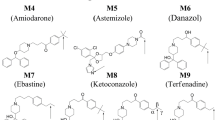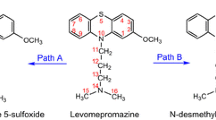Abstract
The metabolism mechanism of (S)-N-[1-(3-morpholin-4ylphenyl)ethyl]-3-phenylacrylamide, mediated by CYP3A4 Cytochrome has been investigated by density functional QM calculations aided with molecular mechanics/molecular dynamics simulations. Two different orientations of phenyl ring for substrate approach toward oxyferryl center, imposing two subsequent rearrangement pathways have been investigated. Starting from σ-complex in perpendicular orientation enzymatic mechanism involves consecutive proton shuttle intermediate, which further leads to the formation of alcohol and ketone. Parallel conformation leads solely to ketone product by 1,2 hydride shift. Although parallel and perpendicular σ-complexes are energetically equivalent both for the gas phase or PCM solvent model, molecular dynamics studies in full CYP3A4 environment show that perpendicular conformation of the σ-complex should be privileged, stabilized by hydrophobic interactions of phenylacrylamide chain. After assessing probability of the two conformations we postulate that the alcohol, accessible with the lowest energy barriers should be the major metabolite for studied substrate and CYP3A4 enzyme.

Orientation of phenyl ring towards porphyrin plane selected by substrate interaction with enzymatic cavity channels enzymatic reaction






Similar content being viewed by others
References
Rendic S, Di Carlo FJ (1997) Drug Metab Rev 29:413–580
Kumar GN, Surapaneni S (2001) Med Res Rev 21:397–411
Guengerich FP (2001) Chem Res Toxicol 14:611–650
Anzenbacher P, Anzenbacherova E (2001) Cell Mol Life Sci 58:737–747
Ekins S, Bravi G, Binkley S, Gillespie JS, Ring BJ, Wikel JH, Wrighton SA (1999) J Pharmacol Exp Ther 290:429–438
Lewis DF, Lake BG (1998) Toxicology 125:31–44
Wu YJ, Boissard CG, Greco C, Gribkoff VK, Harden DG, He H, L’Heureux A, Kang SH, Kinney GG, Knox RJ, Natale J, Newton AE, Lehtinen-Oboma S, Sinz MW, Sivarao DV, Starrett JE Jr, Sun L, Tertyshnikova S, Thompson MW, Weaver D, Wong HS, Zhang L, Dworetzky SI (2003) J Med Chem 46:3197–3200
Wu YJ, Davis CD, Dworetzky S, Fitzpatrick WC, Harden D, He H, Knox RJ, Newton AE, Philip T, Polson C, Sivarao DV, Sun L, Tertyshnikova S, Weaver D, Yeola S, Zoeckler M, Sinz MW (2003) J Med Chem 46:3778–3781
Williams PA, Cosme J, Vinkovic DM, Ward A, Angove HC, Day PJ, Vonrhein C, Tickle IJ, Jhoti H (2004) Science 305:683–686
Yano JK, Wester MR, Schoch GA, Griffin KJ, Stout CD, Johnson EF (2004) J Biol Chem 279:38091–38094
Ekroos M, Sjogren T (2006) Proc Natl Acad Sci USA 103:13682–13687
Sono M, Roach MP, Coulter ED, Dawson JH (1996) Chem Rev 96:2841–2888
Denisov IG, Makris TM, Sligar SG, Schlichting I (2005) Chem Rev 105:2253–2278
Shaik S, Kumar D, de Visser SP, Altun A, Thiel W (2005) Chem Rev 105:2279–2328
Ortiz de Montellano PR, De Voss JJ (2002) Nat Prod Rep 19:477–493
Klamt A, Schüürmann G (1993) J Chem Soc Perkin Trans 2:799–805
Klamt A, Jonas V, Burger T, Lohrenz J (1998) J Phys Chem A 102:5074–5085
Shaikh AR, Broclawik E, Ismael M, Tsuboi H, Koyama M, Kubo M, Del Carpio CA, Miyamoto A (2006) Chem Phys Lett 419:523–527
Visser SP, Shaik S (2003) J Am Chem Soc 125:7413–7424
Bathelt CM, Ridder L, Mulholland AJ, Harvey JN (2003) J Am Chem Soc 125:15004–15005
Bathelt CM, Lars Ridder L, Mulholland AJ, Harvey JN (2004) Org Biomol Chem 2:2998–3005
Luty BA, Wasserman ZR, Stouten PFW, Hodge CN, Zacharias M, McCammon JA (1995) J Comput Chem 16:454–464
Pattabiraman N, Levitt M, Ferrin TE, Langridge R (1985) J Comput Chem 6:432–436
Meng EC, Shoichet BK, Kuntz ID (1992) J Comput Chem 13:505–524
Paulsen MD, Ornstein RL (1991) Proteins 11:184–204
Endou A, Teraishi K, Yajima K, Yoshizawa K, Ohashi N, Takami S, Kubo M, Miyamoto A, Broclawik E (2000) Jpn J Appl Phys 39:4255–4260
Onozu T, Miura R, Takami S, Kubo M, Miyamoto A, Iyechika Y, Maeda T (2000) Jpn J Appl Phys 39:4400–4403
Onozu T, Gunji I, Miura R, Ammal SSC, Kubo M, Teraishi K, Miyamoto A, Iyechika Y, Maeda T (1999) Jpn J Appl Phys 38:2544–2548
Koyama M, Hayakawa J, Onodera T, Ito K, Tsuboi H, Endou A, Kubo M, Del Carpio CA, Miyamoto A (2006) J Phys Chem B 110:17507–17511
Delley B (1990) J Chem Phys 92:508–517
Delley B (2000) J Chem Phys 113:7756–7769
Lundberg M, Siegbahn PEM (2005) J Comput Chem DOI 1002/jcc.2026
Pierloot K, private communication
Radon M, Broclawik E, J Chem Theory Comput (in press)
Dowers TS, Rock DA, Jones JP (2004) J Am Chem Soc 126:8868–8869
Schlichting I, Berendzen J, Chu K, Stock AM, Maves SA, Benson DE, Sweet RM, Ringe D, Petsko GA, Sligar SG (2000) Science 287:1615–1622
Kaizer J, Klinker EJ, Oh NY, Rohde JU, Song WJ, Stubna A, Kim J, Munck E, Nam W, Que L Jr (2004) J Am Chem Soc 126:472–473
Davydov R, Makris TM, Kofman V, Werst DE, Sligar SG, Hoffman BM (2001) J Am Chem Soc 123:1403–1453
Schoneboom JC, Niese F, Thiel W (2005) J Am Chem Soc 127:5840–5853
Yoshizawa K (2002) Coord Chem Rev 226:251–259
Kamachi T, Yoshizawa K (2003) J Am Chem Soc 125:4652–4661
Kamachi T, Shestakov AF, Yoshizawa K (2004) J Am Chem Soc 126:3672–3673
Acknowledgements
We thank Prof. G. D. Szklarz and Mr. Spencer Ericksen, Department of Basic Pharmaceutical Sciences, West Virginia University for kindly providing us CVFF parameters for heme moiety.
This study was partly sponsored by the Polish State Committee for Scientific Research (Grant No. 2 P04A 042 26).
Author information
Authors and Affiliations
Corresponding author
Rights and permissions
About this article
Cite this article
Shaikh, A.R., Broclawik, E., Tsuboi, H. et al. Oxidation mechanism in the metabolism of (S)-N-[1-(3-morpholin-4-ylphenyl)ethyl]-3-phenylacrylamide on oxyferryl active site in CYP3A4 Cytochrome: DFT modeling. J Mol Model 13, 851–860 (2007). https://doi.org/10.1007/s00894-007-0196-5
Received:
Accepted:
Published:
Issue Date:
DOI: https://doi.org/10.1007/s00894-007-0196-5




